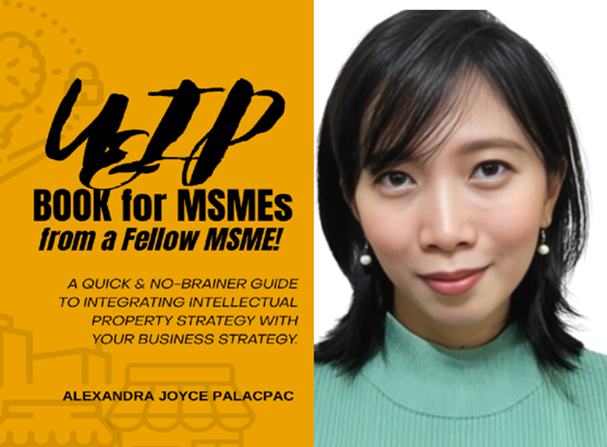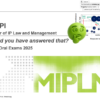From Hidden Assets to Business Advantage: A Game-Changing Guidebook for Micro, Small, and Medium Enterprises
Micro, Small, and Medium Enterprises (MSMEs) are the heartbeat of many economies—agile, creative, and full of potential. Yet too often, their most valuable assets remain unrecognized and unprotected. The guidebook UandIP for MSMEs, by Alexandra Joyce Palacpac, aims to change that. It serves as both a wake-up call and a practical companion for Philippine MSMEs—and by extension, globally—to help them understand, protect, and leverage their intellectual property.
This blog post unpacks the key insights, structure, and importance of this publication. It makes the case that IP is no longer just a legal or bureaucratic necessity, but a business imperative for MSMEs looking to scale and innovate in the knowledge economy.
Why This Guide Matters
The book addresses a knowledge gap that holds back many smaller enterprises: a lack of awareness about the strategic value of IP. While MSMEs are often highly innovative, their understanding of how to identify, protect, and exploit their intangible assets is often minimal. This gap exposes them to the risk of losing market advantage, being imitated by competitors, or missing out on valuable licensing and funding opportunities.
The guide positions IP not as a legal technicality but as a commercial tool—one that can unlock competitive advantage, enhance brand value, and open doors to collaboration and investment. This shift in perspective is vital in an economy where intangible assets often exceed the value of physical ones.
Clear, Structured, and Accessible
The guidebook is remarkably structured and written in a tone that is accessible even to those without prior legal or business training. It uses plain language, real-world examples, and visual aids to break down complex topics. This user-friendliness is particularly important for the MSME audience, where the business owner may also be the marketing manager, the product designer, and the accountant—time and simplicity matter.
It is organized into multiple short chapters, each focused on a key topic such as patents, trademarks, copyrights, industrial designs, geographical indications, and trade secrets. Each section explains what the IP right is, how it works, what it protects, and—crucially—why it matters for MSMEs.
From Awareness to Action
What sets this book apart is its practical orientation. It doesn’t just tell MSMEs what IP is; it tells them what to do with it. This action-oriented approach is reflected in multiple features:
- Step-by-step guidance on how to apply for different IP rights
The guide provides easy-to-follow instructions for filing patents, trademarks, designs, and copyrights. Each process is broken down into manageable steps, helping MSMEs navigate complex procedures with confidence. - Case studies illustrating success stories and cautionary tales
Real-life examples show how MSMEs have leveraged IP to grow, attract investment, or protect their innovations. The guide also includes cautionary tales that highlight the risks of neglecting IP rights or failing to register on time. - Tables that compare costs, timelines, and procedures
Well-structured comparison tables help readers understand the financial and procedural implications of different IP rights. These visual aids support decision-making by clarifying key differences in effort, duration, and expense. - Checklists for innovation audits and IP strategy planning
Practical checklists enable MSMEs to assess their current IP situation and identify areas for improvement. They also serve as tools for planning future IP strategies aligned with business goals. - Clear summaries of government support schemes and subsidies
The guide outlines national programs that offer financial and procedural support for IP registration. It helps MSMEs discover and access subsidies, rebates, and institutional assistance available to them.
This makes the guide not only a source of information but a tool for immediate implementation. It empowers MSMEs to take the next step—be it registering a trademark, protecting a design, or exploring licensing opportunities.
A Focus on Commercialisation
Many IP awareness programs stop at registration. This guide goes further. It places strong emphasis on the commercial potential of IP and how MSMEs can integrate IP into their business models. This includes sections on:
- Monetisation of IP through licensing, franchising, and assignments
- Using IP as collateral for financing
- Strategies for IP valuation
- Collaborating with research institutions under IP-sharing agreements
- Branding strategies based on registered marks and designs
By positioning IP as a revenue-generating asset, the book aligns with global trends where startups and SMEs use intangible assets as bargaining chips in deals, fundraising, and growth partnerships.
Bridging the Knowledge-Action Gap
A recurring challenge for MSMEs is not just lack of awareness, but a sense that IP is something “for large companies.” The guidebook directly counters this myth. It includes relatable stories of small enterprises who secured trademarks for artisanal goods, patented affordable health tech solutions, or leveraged copyright to monetize local content. These cases reinforce that IP is scale-neutral—it protects ideas, not balance sheets.
Additionally, the book demystifies the process. It simplifies IP filings, busts common myths (like “patents are too expensive”), and explains timelines in plain terms. This is critical for creating confidence among MSMEs who may be overwhelmed by the legal complexity or costs of IP registration.
Public and Private Support Systems
Another key strength is how the guide maps out the ecosystem of support. From IP Facilitation Centres to government subsidies under schemes like SIP-EIT, the book makes clear that MSMEs are not alone. It also outlines:
- How to find and work with registered patent and trademark agents
- Support available through industry clusters and incubators
- IP awareness workshops offered by government bodies
- Online databases like IP India and WIPO for conducting prior art searches
This ecosystem view encourages MSMEs to plug into networks, take advantage of shared resources, and avoid common mistakes made in isolation.
Global Perspective, Local Action
While the guidebook is tailored to Indian MSMEs, its lessons apply globally. The challenges it addresses—low IP awareness, risk of misappropriation, undervaluation of intangible assets—are common to MSMEs everywhere.
Its global relevance is further reinforced by sections that discuss international IP protection, such as:
- Filing patents under the Patent Cooperation Treaty (PCT)
- Madrid Protocol for international trademarks
- Hague Agreement for industrial designs
- Copyright protection under the Berne Convention
These insights help MSMEs prepare for export markets, cross-border licensing, and IP strategy alignment with global partners.
Integration with Business Strategy
A particularly noteworthy message in the book is that IP must not be a stand-alone activity. It needs to be integrated into product development, branding, and growth strategies. For example:
- A startup should consider patenting during the prototyping phase, not after commercialization
- A design-centric business should protect visual identity alongside brand names
- Software developers should consider both copyright and licensing agreements from the outset
These insights help MSMEs avoid a reactive or piecemeal approach to IP. Instead, they are encouraged to build IP thinking into their business DNA.
Challenges Acknowledged, Solutions Offered
The book does not sugarcoat the challenges. It acknowledges that MSMEs may face barriers such as:
- Lack of in-house legal expertise
- Limited budgets for IP protection
- Inadequate documentation of innovations
- Difficulty navigating international IP systems
But for each challenge, it offers concrete solutions: capacity building, outsourcing to IP professionals, using digital tools for tracking, and leveraging public support. It also encourages MSMEs to document their innovation process early and often, which is key in IP disputes and filings.
Educational and Inspirational
Beyond practical advice, the book serves as an inspiration. It communicates that intellectual creativity is valuable—that a better textile weave, a unique packaging design, or a catchy brand name can hold serious business potential if protected and managed wisely.
This is particularly empowering for entrepreneurs in rural areas or traditional industries who may have never thought of their knowledge as “intellectual property.” By giving language and structure to their innovations, the book validates their contributions to the economy.
A Tool for Policy and Ecosystem Builders
While the primary audience is MSMEs, this guidebook is also a useful resource for policymakers, incubators, educators, and business associations. It provides a roadmap for structuring IP outreach, designing SME support programs, and aligning public resources with enterprise needs.
It can be used as a curriculum base in entrepreneurship courses or IP awareness drives. It also provides a common vocabulary that connects lawyers, entrepreneurs, and administrators—helping to build a more coherent IP ecosystem.
What Could Be Improved
While the book is strong overall, there are areas for further enrichment:
- More digital tools and tech platforms could be listed for modern IP management
- Case studies from newer sectors like healthtech, edtech, and AI startups could broaden relevance
- A deeper section on trade secrets and cybersecurity for IP would address rising concerns in tech-enabled MSMEs
Still, these are areas for future editions. The current guide is already an essential resource for its intended audience.
A Timely Guide for the Knowledge Economy
UandIP for MSMEs delivers on its promise—it builds awareness and lays out a clear path for commercialization. In doing so, it not only protects innovation but empowers economic growth at the grassroots level.
In a world where ideas are currency, this book equips MSMEs with the tools to recognize, value, and protect their intellectual gold. For any small enterprise aiming to grow smartly in a competitive, knowledge-driven marketplace, this guidebook is not just recommended—it is essential.
If you’re an MSME founder, innovation officer, or startup incubator, this publication deserves a place in your toolkit. And if you’re an IP professional, it offers a powerful reminder of your role—not just as a service provider, but as an enabler of innovation and inclusive growth.




